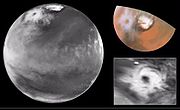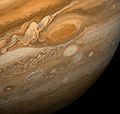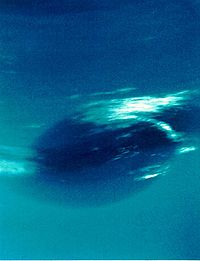
Extraterrestrial cyclone
Encyclopedia
Extraterrestrial cyclones are cyclone
s found on other planet
s.
has two large long-lived pairs of inverted anticyclones
, one pair near each pole (polar vortexes
), discovered in 2007 by the Venus Express
probe.
 On April 27, 1999, a rare cyclone 1,100 miles in diameter was detected by the Hubble Space Telescope
On April 27, 1999, a rare cyclone 1,100 miles in diameter was detected by the Hubble Space Telescope
in the northern polar
region of Mars
. It consisted of three cloud bands wrapped around a massive 200 miles (321.9 km) eye, and contained features similar to storms that have been detected in the poles of Earth. It was only observed briefly, as it seemed to be dissipating when it was imaged six hours later, and was not seen on later imaging passes. Several other cyclones were imaged in about the same area, like the March 2, 2001 cyclone, 19 January 2003 cyclone, 27 November 2004 cyclone (Dust devil
s have also been observed on Mars.)
Snow was detected in the sky on Mars by Nasa's Phoenix Mars Lander, however, the snow vaporised before contacting the surface.
 The Great Red Spot is, by far, the largest extraterrestrial anticyclone (or cyclone) known. It is so large that about 2 to 3 Earths could fit inside it. The Great Red Spot has existed on Jupiter for at least 340 years. In the image at the left, the Great Red Spot can be seen near the top center. The Great Red Spot has turned dull pink, to bright red, but has not yet dissipated and is not likely to do so in the near future.
The Great Red Spot is, by far, the largest extraterrestrial anticyclone (or cyclone) known. It is so large that about 2 to 3 Earths could fit inside it. The Great Red Spot has existed on Jupiter for at least 340 years. In the image at the left, the Great Red Spot can be seen near the top center. The Great Red Spot has turned dull pink, to bright red, but has not yet dissipated and is not likely to do so in the near future.
Oval BA (or Red Spot Jr.) is a remnant formed from the merger of multiple white ovals. It is located just to the south of the Great Red Spot and has been increasing in strength.
spacecraft took images of a storm with a well-defined distinct eyewall over the South Pole. It was across, with storms in the eyewall reaching 70 km (40 mi) high. The storm had windspeeds of 550 km/h (340 mph) and appeared to be stationary over Saturn's South Pole.
In addition, several storms like the Great White Spot
occasionally appear on the surface of Saturn, becoming large enough to be spotted by telescopes on Earth
.
There is also a long-lived storm known as the Dragon Storm
, which flares occasionally.
A hexagonal cyclone in Saturn's northern hemisphere has been spotted since the passage of Voyager 1
and 2
, and has recently also been imaged by Cassini
. It is just under 15,000 miles (25,000 km) in diameter, with a depth of about 60 miles (100 km), and encircles the north pole of Saturn at roughly 78° N latitude.
 The Great Dark Spot
The Great Dark Spot
was an anticyclone (possibly an atmospheric hole, similar to the ozone hole
) discovered by Voyager 2
in 1989. It was approximately the same size as Eurasia
.
 The Wizard's Eye
The Wizard's Eye
(sometimes called Great Dark Spot 2) is another cyclone on Neptune. It is about one-third the diameter of the Great Dark Spot. It received the name "Wizard's Eye" because it looks like an eye. This appearance is caused by a white cloud in the middle of the Wizard's Eye.
Cyclone
In meteorology, a cyclone is an area of closed, circular fluid motion rotating in the same direction as the Earth. This is usually characterized by inward spiraling winds that rotate anticlockwise in the Northern Hemisphere and clockwise in the Southern Hemisphere of the Earth. Most large-scale...
s found on other planet
Planet
A planet is a celestial body orbiting a star or stellar remnant that is massive enough to be rounded by its own gravity, is not massive enough to cause thermonuclear fusion, and has cleared its neighbouring region of planetesimals.The term planet is ancient, with ties to history, science,...
s.
Venus
VenusVenus
Venus is the second planet from the Sun, orbiting it every 224.7 Earth days. The planet is named after Venus, the Roman goddess of love and beauty. After the Moon, it is the brightest natural object in the night sky, reaching an apparent magnitude of −4.6, bright enough to cast shadows...
has two large long-lived pairs of inverted anticyclones
Anticyclone
An anticyclone is a weather phenomenon defined by the United States' National Weather Service's glossary as "[a] large-scale circulation of winds around a central region of high atmospheric pressure, clockwise in the Northern Hemisphere, counterclockwise in the Southern Hemisphere"...
, one pair near each pole (polar vortexes
Polar vortex
A polar vortex is a persistent, large-scale cyclone located near one or both of a planet's geographical poles. On Earth, the polar vortices are located in the middle and upper troposphere and the stratosphere...
), discovered in 2007 by the Venus Express
Venus Express
Venus Express is the first Venus exploration mission of the European Space Agency. Launched in November 2005, it arrived at Venus in April 2006 and has been continuously sending back science data from its polar orbit around Venus. Equipped with seven science instruments, the main objective of the...
probe.
Mars

Hubble Space Telescope
The Hubble Space Telescope is a space telescope that was carried into orbit by a Space Shuttle in 1990 and remains in operation. A 2.4 meter aperture telescope in low Earth orbit, Hubble's four main instruments observe in the near ultraviolet, visible, and near infrared...
in the northern polar
Magnetic pole
Magnetic pole may refer to:* One of the two ends of a magnet* The magnetic poles of astronomical bodies, a special case of magnets, two special cases of which are the Geomagnetic poles:...
region of Mars
Mars
Mars is the fourth planet from the Sun in the Solar System. The planet is named after the Roman god of war, Mars. It is often described as the "Red Planet", as the iron oxide prevalent on its surface gives it a reddish appearance...
. It consisted of three cloud bands wrapped around a massive 200 miles (321.9 km) eye, and contained features similar to storms that have been detected in the poles of Earth. It was only observed briefly, as it seemed to be dissipating when it was imaged six hours later, and was not seen on later imaging passes. Several other cyclones were imaged in about the same area, like the March 2, 2001 cyclone, 19 January 2003 cyclone, 27 November 2004 cyclone (Dust devil
Dust devil
A dust devil is a strong, well-formed, and relatively long-lived whirlwind, ranging from small to large . The primary vertical motion is upward...
s have also been observed on Mars.)
Snow was detected in the sky on Mars by Nasa's Phoenix Mars Lander, however, the snow vaporised before contacting the surface.
Jupiter

Oval BA (or Red Spot Jr.) is a remnant formed from the merger of multiple white ovals. It is located just to the south of the Great Red Spot and has been increasing in strength.
Saturn
On October 11, 2006, the Cassini-HuygensCassini-Huygens
Cassini–Huygens is a joint NASA/ESA/ASI spacecraft mission studying the planet Saturn and its many natural satellites since 2004. Launched in 1997 after nearly two decades of gestation, it includes a Saturn orbiter and an atmospheric probe/lander for the moon Titan, although it has also returned...
spacecraft took images of a storm with a well-defined distinct eyewall over the South Pole. It was across, with storms in the eyewall reaching 70 km (40 mi) high. The storm had windspeeds of 550 km/h (340 mph) and appeared to be stationary over Saturn's South Pole.
In addition, several storms like the Great White Spot
Great White Spot
The Great White Spot, also known as Great White Oval, on Saturn, named by analogy to Jupiter's Great Red Spot, is a name given to periodic storms that are large enough to be visible by telescope from Earth by their characteristic white appearance...
occasionally appear on the surface of Saturn, becoming large enough to be spotted by telescopes on Earth
Earth
Earth is the third planet from the Sun, and the densest and fifth-largest of the eight planets in the Solar System. It is also the largest of the Solar System's four terrestrial planets...
.
There is also a long-lived storm known as the Dragon Storm
Dragon Storm (astronomy)
Dragon Storm is a large, bright and complex convective storm in Saturn's southern hemisphere. The Saturnian storm appears to be long-lived and periodically flares up to produce dramatic white plumes which then subside...
, which flares occasionally.
A hexagonal cyclone in Saturn's northern hemisphere has been spotted since the passage of Voyager 1
Voyager 1
The Voyager 1 spacecraft is a 722-kilogram space probe launched by NASA in 1977, to study the outer Solar System and eventually interstellar space. Operating for as of today , the spacecraft receives routine commands and transmits data back to the Deep Space Network. At a distance of as of...
and 2
Voyager 2
The Voyager 2 spacecraft is a 722-kilogram space probe launched by NASA on August 20, 1977 to study the outer Solar System and eventually interstellar space...
, and has recently also been imaged by Cassini
Cassini-Huygens
Cassini–Huygens is a joint NASA/ESA/ASI spacecraft mission studying the planet Saturn and its many natural satellites since 2004. Launched in 1997 after nearly two decades of gestation, it includes a Saturn orbiter and an atmospheric probe/lander for the moon Titan, although it has also returned...
. It is just under 15,000 miles (25,000 km) in diameter, with a depth of about 60 miles (100 km), and encircles the north pole of Saturn at roughly 78° N latitude.
Great Dark Spot

Great Dark Spot
The Great Dark Spot is the name given to a series of dark spots on Neptune similar in appearance to Jupiter's Great Red Spot. The first one was observed in 1989 by NASA's Voyager 2 probe. Like Jupiter's spot, they are anticyclonic storms...
was an anticyclone (possibly an atmospheric hole, similar to the ozone hole
Ozone depletion
Ozone depletion describes two distinct but related phenomena observed since the late 1970s: a steady decline of about 4% per decade in the total volume of ozone in Earth's stratosphere , and a much larger springtime decrease in stratospheric ozone over Earth's polar regions. The latter phenomenon...
) discovered by Voyager 2
Voyager 2
The Voyager 2 spacecraft is a 722-kilogram space probe launched by NASA on August 20, 1977 to study the outer Solar System and eventually interstellar space...
in 1989. It was approximately the same size as Eurasia
Eurasia
Eurasia is a continent or supercontinent comprising the traditional continents of Europe and Asia ; covering about 52,990,000 km2 or about 10.6% of the Earth's surface located primarily in the eastern and northern hemispheres...
.
Small Dark Spot

Wizard's eye
The Small Dark Spot, sometimes also called Dark Spot 2 or The Wizard's Eye, was a southern cyclonic storm on the planet Neptune. It was the second most intensive storm on the planet in 1989, when Voyager 2 flew by the planet. It disappeared in 1994.-See also:*Extraterrestrial cyclone*Oval BA*Great...
(sometimes called Great Dark Spot 2) is another cyclone on Neptune. It is about one-third the diameter of the Great Dark Spot. It received the name "Wizard's Eye" because it looks like an eye. This appearance is caused by a white cloud in the middle of the Wizard's Eye.

